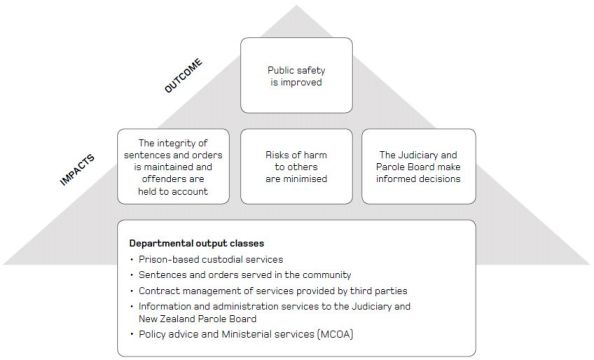Public safety

Keeping communities safe by ensuring offenders complete the sentences and orders handed down by our justice system. This will always be our bottom line.
For New Zealand to have a successful justice system, public safety must be maintained.
This means that offenders serve the sentences and orders they are sentenced to by the courts; that Corrections manages sentences and orders in ways that meet the legislative requirements; and that the Judiciary and New Zealand Parole Board base their decisions about offenders on good quality information.
Public safety is improved when:
- the prison environment is safe and secure for prisoners, staff, prison visitors and the general public
- probation officers are equipped to do their job safely and effectively
- offenders comply with the sentences and orders they were sentenced to by the courts, and are held to account when they do not
- sentences and orders are managed in ways that meet legislative requirements
- the Judiciary and New Zealand Parole Board have good quality information on which to base decisions about offenders.
The public expects that prisoners will be accommodated securely. They also expect that community-based offenders will comply with their sentences and orders. It is our bottom line responsibility to ensure this happens consistently across the Corrections system. Levels of compliance with sentences and orders are at their highest, and rates of breakout escapes and indicators of contraband are at their lowest ever levels. We will further this success by keeping more contraband out of our prisons, improving staff safety wherever possible, and managing community-based offenders to increase levels of compliance with sentences and orders.
|
We will demonstrate success through:
|
This outcome is supported by three impacts:
- the integrity of sentences and orders is maintained and offenders are held to account
- risks of harm to others are minimised
- the Judiciary and New Zealand Parole Board make informed decisions.
The integrity of sentences and orders is maintained and offenders are held to account |
The integrity of sentences and orders is maintained when corrections facilities have few escapes and there is minimal crime within prisons (such as introduced contraband).
In recent years, we have greatly reduced the levels of escapes and levels of contraband in our prisons. Break-out escapes have reduced from 11 in the 2005/06 financial year, to two in 2010/11. Levels of positive general random drug tests have reduced from 15 percent in 2005/06 to seven percent in 2010/11.
Over the next three years we will ensure that the integrity of sentences and orders is maintained and offenders are held to account by:
- introducing a consistent set of security regimes across the prison network following on from the National Security Review, upgrading our prisons and relocating prisoners where necessary to achieve best design principles for the safety, humane containment and rehabilitation of prisoners
- ensuring further reduced levels of contraband in prisons by introducing additional drug dog teams performing search duties in our prisons
- modernising the way we manage offenders in the community, targeting our resources at effectively managing our highest risk offenders
- introducin g drug and alcohol testing for some community-based offenders.
|
We will demonstrate success through:
|
Risks of harm to others are minimised |
We manage of fenders in ways that minimises their risk of harm to others. This means managing prisoners to prevent assaults on staff and other prisoners. All instances
of serious assault on staff are investigated, and the Department is committed to addressing the slight increase in levels of assaults recorded over the past two years.
In the community, it means reducing the risk that offenders pose to staff and other offenders, and especially to the wider community.
Over the next three years we will ensure that the risk of harm to others is minimised by:
- improving the safety of our frontline staff, becoming experts in identifying and managing the risks that we face each day, such as offender behaviour
- working alongside the Ministry of Justice to develop legislation to keep those offenders who are at very high risk of imminent serious sexual or violent
re-offending detained on public protection orders - fully exploring emergent GPS technologies to better track the offenders we manage.
|
We will demonstrate our success by 2015 through:
|
The Judiciary and New Zealand Parole Board make informed decisions |
The Judiciary and New Zealand Parole Board make decisions that are, in part, based on information provided by Corrections staff in reports, and at court and NZPB hearings.
The Department will continue to support the Judiciary and New Zealand Parole Board by ensuring that they have the right information at the right time to support their
decision making. We will continue to ensure that they have high quality information of the offender’s risk to others and likelihood of re-offending to provide a well-rounded
picture to the court or NZPB.
Victims are at the centre of our concern, and we will continue to ensure they are notified about hearings and releases. Offenders will likewise be notified
as per the NZPB’s requirements.
Over the next three years we will support the Judiciary and New Zealand Parole Board to make informed decisions by:
- reducing unnece ssary parole hearings by increasing the maximum allowable interval between hearings to achieve significant savings and alleviate stress
on victims of crime.
|
We will demonstrate our success by 2015 through:
|

